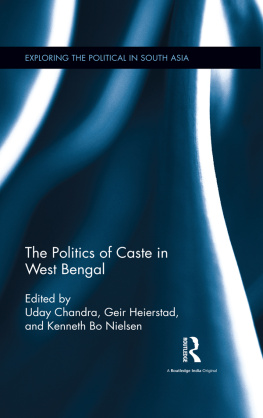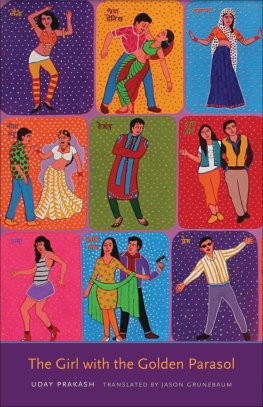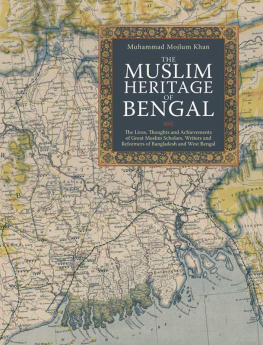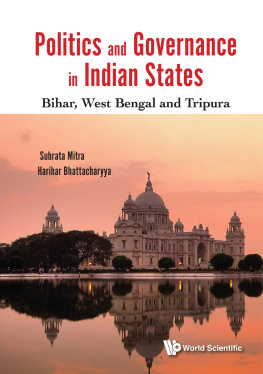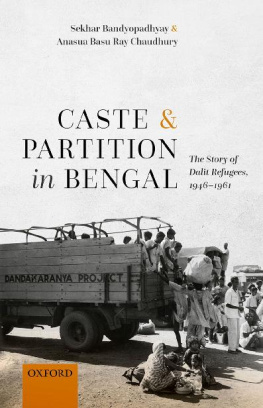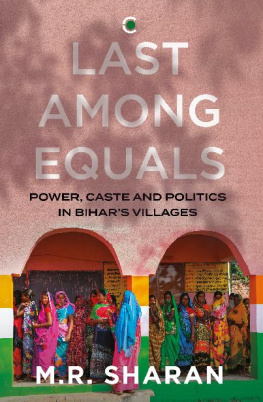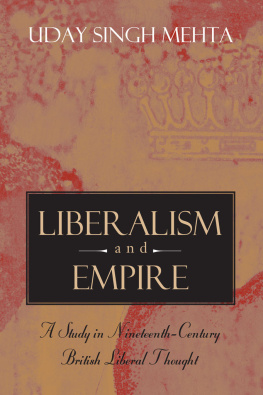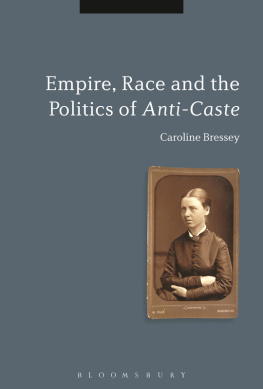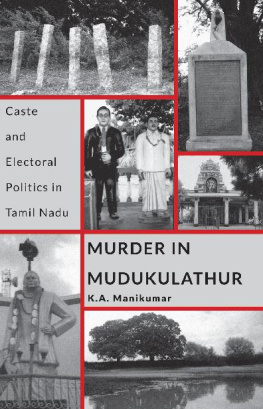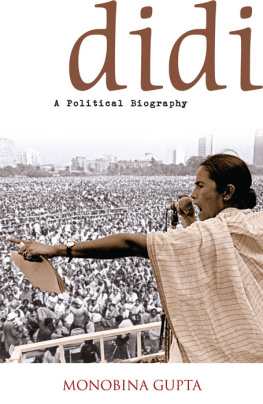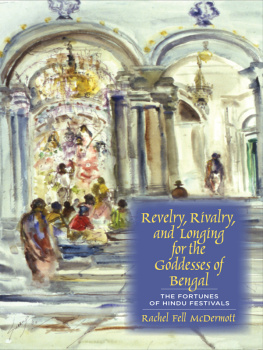Chandra Uday - The politics of caste in West Bengal
Here you can read online Chandra Uday - The politics of caste in West Bengal full text of the book (entire story) in english for free. Download pdf and epub, get meaning, cover and reviews about this ebook. City: India--West Bengal., year: 2016, publisher: Routledge, genre: Politics. Description of the work, (preface) as well as reviews are available. Best literature library LitArk.com created for fans of good reading and offers a wide selection of genres:
Romance novel
Science fiction
Adventure
Detective
Science
History
Home and family
Prose
Art
Politics
Computer
Non-fiction
Religion
Business
Children
Humor
Choose a favorite category and find really read worthwhile books. Enjoy immersion in the world of imagination, feel the emotions of the characters or learn something new for yourself, make an fascinating discovery.
- Book:The politics of caste in West Bengal
- Author:
- Publisher:Routledge
- Genre:
- Year:2016
- City:India--West Bengal.
- Rating:3 / 5
- Favourites:Add to favourites
- Your mark:
- 60
- 1
- 2
- 3
- 4
- 5
The politics of caste in West Bengal: summary, description and annotation
We offer to read an annotation, description, summary or preface (depends on what the author of the book "The politics of caste in West Bengal" wrote himself). If you haven't found the necessary information about the book — write in the comments, we will try to find it.
The politics of caste in West Bengal — read online for free the complete book (whole text) full work
Below is the text of the book, divided by pages. System saving the place of the last page read, allows you to conveniently read the book "The politics of caste in West Bengal" online for free, without having to search again every time where you left off. Put a bookmark, and you can go to the page where you finished reading at any time.
Font size:
Interval:
Bookmark:
First published 2016
by Routledge
2 Park Square, Milton Park, Abingdon, Oxon OX14 4RN
and by Routledge
711 Third Avenue, New York, NY 10017
Routledge is an imprint of the Taylor & Francis Group, an informa business
2016 Uday Chandra, Geir Heierstad, and Kenneth Bo Nielsen
The right of Uday Chandra, Geir Heierstad, and Kenneth Bo Nielsen to be identified as the authors of the editorial material, and of the authors for their individual chapters, has been asserted in accordance with sections 77 and 78 of the Copyright, Designs and Patents Act 1988.
All rights reserved. No part of this book may be reprinted or reproduced or utilised in any form or by any electronic, mechanical, or other means, now known or hereafter invented, including photocopying and recording, or in any information storage or retrieval system, without permission in writing from the publishers.
Trademark notice: Product or corporate names may be trademarks or registered trademarks, and are used only for identification and explanation without intent to infringe.
British Library Cataloguing-in-Publication Data
A catalogue record for this book is available from the British Library
Library of Congress Cataloging-in-Publication Data
Catalog record for this book has been requested
ISBN: 978-1-138-92148-1 (hbk)
ISBN: 978-1-315-68631-8 (ebk)
Typeset in Sabon
by Apex CoVantage LLC

Caste is not important in Bengal is an often-repeated phrase in discussions of contemporary India. It is used when comparing West Bengal with other states, where caste is considered a more determining factor in many issues. What is, of course, meant by this remark is that the democratic upsurge that India has witnessed in large parts of the country since the 1990s, which mobilised lower castes into active political participation and gave them an unprecedented visibility in electoral politics, did not happen in Bengal in the same way. This argument of the relative lack of importance of caste in Bengal is further supported by the lack of any of Bengals major political parties being associated with any particular caste or cluster of castes; it has been dominated first by the Congress, and then by the Left Front for most of its postcolonial history and neither party has advocated a caste-based identity or interest.
But this leads to the crucial question whether the absence of caste as a mobilisation strategy in electoral politics justifies its dismissal in shaping the politics of Bengal? Or indeed, does the very dismissal indicate a nascent upper-caste bias in how the narrative of the politics of Bengal is told? Given the importance of Bengals intellectual and cultural leadership in shaping Indias social renaissance and the nationalist movement, this question has salience not just for an understanding of Bengal, but that of India as a whole.
This volume addresses this important issue head-on and does it with academic thoroughness. The editors have been driven by the urgency of this question through observing the politics of contemporary Bengal, which each of them do in their individual capacity. But they also recognise that it is impossible (like so many other issues in understanding the political in South Asia) to gain any understanding of it without going back at least 200 years in the region. Thus, in this volume, historians first provide fine-grained case studies of particular castes and place them within the wider canvas of the hugely innovative and exciting politics of 19th-century Bengal. Their sociologist and anthropologist colleagues are then able to do the same with more contemporary examples by placing particular incidents of caste mobilisations, displacements, and changing hierarchies within the wider politics of Communism and its challengers.
This volume shows that, whatever the time period examined or the disciplinary lens through which it is examined, the puzzle of how a tiny majority of upper castes (about 10 per cent in the early 20th century) were able to exercise a remarkable hegemonic hold over the rest of the population remains. There have been no bahujan political parties in West Bengal, as in north India, nor has there been an anti-Brahmin movement, as in south India. It begs the question as to why Bengal is so different and, predictably, the answer is complex. It has to be first recognised that the distinguishing feature of the Bengal elite, the bhadralok a group that had otherwise caste ramifications within it is their collective complete disavowal of manual work. The aspiration for any of the lower castes to become a member of the bhadralok required, therefore, first and foremost, their ability to give up manual work. But as the accounts in this book show, the elites deployed a number of strategies to keep this from happening. A wide variety of governance strategies such as the stereotyping of lower castes and indigenous peoples, determining the settlement destinations of refugee populations from the east during and just after Partition, and their mastery of electoral strategies in independent India maintained their dominance. Also, as the scholars in this volume and beyond have pointed out, factors such as Partition also made the sort of alliance between Muslims and lower-caste peasants, which we have seen in other parts of India, difficult. Further, the lower castes themselves Rajbanshi, Namshudra, Bagdi, and Paindra do not share many commonalities to unite under a single banner. Thus, the combination of post-Partition dynamics, the advent of electoral politics, and the lack of a single mobilising caste identity together created conditions under which lower-caste politics of the sort we have seen elsewhere in India is well-nigh impossible in Bengal.
In addition, the dominance first of Congress politics and then the alliance of the Left Front parties for much of postcolonial Bengal has been no small factor. Caste was not the determining factor in the electoral strategy for either political formation and the 34 year period of communist rule gave rise to the notion that class was the more important variable for determining electoral fortunes than caste. Furthermore, vote share figures at each election gave rise to the notion of the Muslim block vote, similar to those elsewhere in India, and one which the winning party got. The lack of precision of these ideas is no more evident than in the villages, where my own research has been based for the past 15 years. There, among the Muslims who form the majority of paddy cultivators, there are four castes Syeds, Shekhs, Mughals, and Pathans. The Syeds own the land, the rest work as sharecroppers or daily wage labourers. The land reforms of the 1980s changed this scenario and led to new dynamics of ownership, income, and mutuality. The local village comrade, as perfect reflection of the membership of the CPI(M)s politburo, is an upper-caste Syed who formed his fiefdom by mobilising the labouring castes. However, his machinations also alienated most of the other upper-caste Syeds, but not all. In addition, his uneven dealings had also alienated some of the Shekhs and Pathans. During elections, people tended to vote on the basis of which party they felt most attachment for and on the basis of kinship links. Thus, both the Congress and Left Front vote contained many upper- and lower-caste votes, each formed according to a complex algorithm of loyalty, caste, and class identities. This changed further with the rise of Trinamul Congress. Thus, the dynamics of caste in a Muslim setting and a quarter of West Bengals populations is Muslim is far from predictable, certainly not replaced by class and upper-caste hegemony has been enhanced by the long years of the Left Front.
Font size:
Interval:
Bookmark:
Similar books «The politics of caste in West Bengal»
Look at similar books to The politics of caste in West Bengal. We have selected literature similar in name and meaning in the hope of providing readers with more options to find new, interesting, not yet read works.
Discussion, reviews of the book The politics of caste in West Bengal and just readers' own opinions. Leave your comments, write what you think about the work, its meaning or the main characters. Specify what exactly you liked and what you didn't like, and why you think so.

